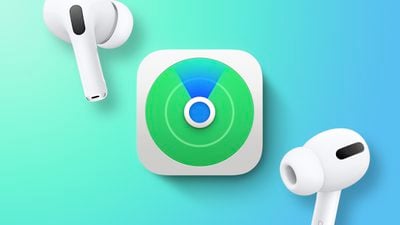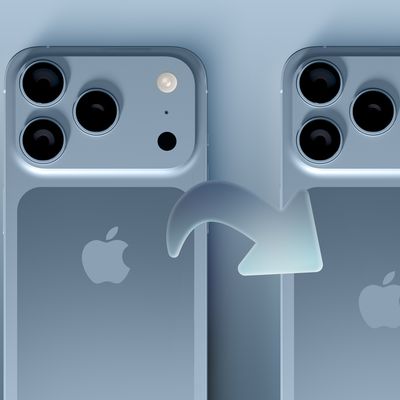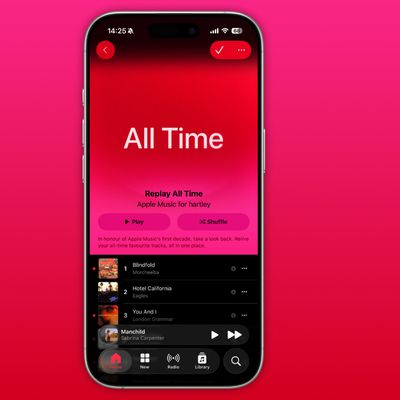AirPods Find My Network Support Includes Tethering to Apple ID and New Manual Unpairing Process
Apple announced earlier this year that, with iOS 15 and iPadOS 15, the Find My Network will be able to locate AirPods Pro and AirPods Max. Now, it has emerged that this will be achieved by tethering the AirPods to a specific Apple ID, with an unusual system of covering the AirPods Pro's speaker holes to remove the linked account.

First spotted by 9to5Mac, iOS 15 developer beta five code has confirmed that, to work with Apple's Find My Network, AirPods Pro and AirPods Max will need to be tethered to an Apple ID. This means that even if a user connects someone else's AirPods to their device, they will remain tethered to the owner's Apple ID.
To remove the configured Apple ID and disable connection to the Find My Network, such as when passing the AirPods to a new user, owners will have to follow a number of manual steps similar to the process for untethering an AirTag.
For AirPods Max, users need to hold down the Active Noise Cancelation button at the same time as the Digital Crown for 12 seconds. For AirPods Pro, users have to cover the interior and exterior grilles with their fingers while pressing the button on the stem three times in sequence.
Support for the Find My Network will likely come via an AirPods Pro and AirPods Max firmware update alongside iOS 15 and iPadOS 15 later in the fall. First and second-generation AirPods will not support the Find My Network.
Previously, all AirPods devices appeared in the Find My app, but were not remotely locatable using the Find My Network like an AirTag, which uses low-energy Bluetooth to feed a device's location back to the owner via nearby iPhone or iPad.
Popular Stories
Apple's next-generation iPhone 17 Pro and iPhone 17 Pro Max are less than three months away, and there are plenty of rumors about the devices.
Apple is expected to launch the iPhone 17, iPhone 17 Air, iPhone 17 Pro, and iPhone 17 Pro Max in September this year.
Below, we recap key changes rumored for the iPhone 17 Pro models:Aluminum frame: iPhone 17 Pro models are rumored to have an...
Apple is developing a MacBook with the A18 Pro chip, according to findings in backend code uncovered by MacRumors.
Earlier today, Apple analyst Ming-Chi Kuo reported that Apple is planning to launch a low-cost MacBook powered by an iPhone chip. The machine is expected to feature a 13-inch display, the A18 Pro chip, and color options that include silver, blue, pink, and yellow.
MacRumors...
The upcoming iPhone 17 Pro and iPhone 17 Pro Max are rumored to have a slightly different MagSafe magnet layout compared to existing iPhone models, and a leaked photo has offered a closer look at the supposed new design.
The leaker Majin Bu today shared a photo of alleged MagSafe magnet arrays for third-party iPhone 17 Pro cases. On existing iPhone models with MagSafe, the magnets form a...
The long wait for an Apple Watch Ultra 3 appears to be nearly over, and it is rumored to feature both satellite connectivity and 5G support.
Apple Watch Ultra's existing Night Mode
In his latest Power On newsletter, Bloomberg's Mark Gurman said that the Apple Watch Ultra 3 is on track to launch this year with "significant" new features, including satellite connectivity, which would let you...
Apple is planning to launch a low-cost MacBook powered by an iPhone chip, according to Apple analyst Ming-Chi Kuo.
In an article published on X, Kuo explained that the device will feature a 13-inch display and the A18 Pro chip, making it the first Mac powered by an iPhone chip. The A18 Pro chip debuted in the iPhone 16 Pro last year. To date, all Apple silicon Macs have contained M-series...
Apple today seeded the second betas of upcoming iOS 18.6 and iPadOS 18.6 updates to public beta testers, with the betas coming just a day after Apple provided the betas to developers. Apple has also released a second beta of macOS Sequoia 15.6.
Testers who have signed up for beta updates through Apple's beta site can download iOS 18.6 and iPadOS 18.6 from the Settings app on a compatible...
iOS 26 and iPadOS 26 add a smaller yet useful Wi-Fi feature to iPhones and iPads.
As spotted by Creative Strategies analyst Max Weinbach, sign-in details for captive Wi-Fi networks are now synced across iPhones and iPads running iOS 26 and iPadOS 26. For example, while Weinbach was staying at a Hilton hotel, his iPhone prompted him to fill in Wi-Fi details from his iPad that was already...
Apple hasn't updated the AirPods Pro since 2022, and the earbuds are due for a refresh. We're counting on a new model this year, and we've seen several hints of new AirPods tucked away in Apple's code. Rumors suggest that Apple has some exciting new features planned that will make it worthwhile to upgrade to the latest model.
Subscribe to the MacRumors YouTube channel for more videos.
Heal...
As part of its 10-year celebrations of Apple Music, Apple today released an all-new personalized playlist that collates your entire listening history.
The playlist, called "Replay All Time," expands on Apple Music's existing Replay features. Previously, users could only see their top songs for each individual calendar year that they've been subscribed to Apple Music, but now, Replay All...























